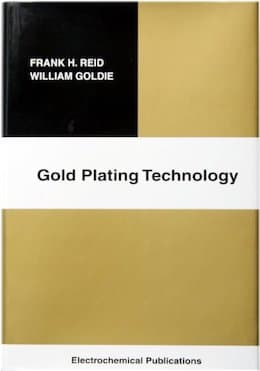
-----
Enlarge the crystal in 24k gold electroforming
Q. Hello everyone,
Can anyone let me know that by adding what kind of Carboxylic acid will lead to increase the crystal size formed during a 24k gold electroforming process ?
Thanks,
Jewellery - Hong Kong
October 18, 2009
by Reid & Goldie
-- hard to find & expensive; if you see a copy cheap, act fast!

on eBay or Amazon
or AbeBooks
(affil link)
Q. Hello Everybody,
To read this panel is quite helpful to all readers!
I would like to further elaborate my question: We are doing a phosphate base gold salt with Potassium Gold Cyanide as electrolyte to do electroforming process being controlled to neutral pH (at about 6.3 to 6.7) to make hollow 24k pure gold products with various shapes. We would like to know by adding what kind of Carboxylic acid or any other methods that will lead to increase the crystal size formed in the products, or to say that we would want to increase the hardness or the surface brightness of the products.
I will be deeply grateful for the help from all of you!
Thanks a lot!
- Hong Kong
November 9, 2009
A. Henry,
Responders on this website may be a little leery to give you exact formulas. What if we gave you the wrong data, and your gold bath needed replacing because of it? I'm sure you see my point.
I will say however, pyridine compounds (pyridine-3 carboxylic acid) and other compounds have been proven through research and used in production. These additives are generally proprietary in relation to type, concentration, and make-up addition amounts to the bath itself. Your gold supplier should be able to pay you a visit, and get you exactly what you need for the bath. Good Luck!
process engineer - Malone, New York
November 10, 2009
![]() Hi Mark,
Hi Mark,
Thank you very much for your comment !
We will test it in a breaker. Our anode is Pt mesh.
Many Thanks...!
- Hong Kong
November 11, 2009
Q. Dear Mark,
I have one question about pyridine-3 carboxylic acid to increase the crystal size formed (Effect of casting sand) in the 24K gold products. Currently our gold bath is containing the following ingredients:
1. phosphoric acid
2. KOH or NaOH
3. Gold cyanide
We really appreciate if you can help us to confirm that the pyridine-3 carboxylic acid will increase the crystal size and will have the effect of casting sand in the 24K gold products for our gold bath condition. Thank you.
Best Regards,
Philip
- Hong Kong
February 3, 2010
|
A. Philip, process engineer - Malone, New York A. Dear Philip  Pat Mentone St Paul, Minnesota |
|
A. Although I am probably out of date, the proprietary pure neutral phosphate (usually phosphate/citrate) systems I have used contained a grain refiner. If I remember right, thallium sulphate was commonly used for this. Even so, I have never seen deposits from these baths that were very bright, at least compared with the common acid citrate baths that contain small amounts of Ni, Co, or In. It seems to me that, with the phosphate system, the brighter you make the deposit, the greater the stress you will have. And, of course, the higher the stress, the less chance electroforming will be successful. - Nevada, Missouri A. Henry  Geoff Smith Hampshire, England |
Q. Dear Mark,
Currently we regulate the pH values based on phosphoric acid and KOH ratio. You suggest to vary plating times and current densities to determine the altered grain structure. So do you still recommend us to add pyridine compounds (pyridine-3 carboxylic acid)?
Thanks.
Philip
- Hong Kong
February 6, 2010
A. Philip,
No, I wouldn't use the pyridine compound(s). As Pat Mentone points out, lower current densities would increase the grain size of the deposit. Try it in the lab to see if you can achieve this.
process engineer - Malone, New York
February 10, 2010
![]() Dear all,
Dear all,
Thanks so much for your advice and great support.
Best Regards,
- Hong Kong
February 20, 2010
Q, A, or Comment on THIS thread -or- Start a NEW Thread
Disclaimer: It's not possible to fully diagnose a finishing problem or the hazards of an operation via these pages. All information presented is for general reference and does not represent a professional opinion nor the policy of an author's employer. The internet is largely anonymous & unvetted; some names may be fictitious and some recommendations might be harmful.
If you are seeking a product or service related to metal finishing, please check these Directories:
Finishing
Jobshops
Capital
Equipment
Chemicals &
Consumables
Consult'g,
& Software
About/Contact - Privacy Policy - ©1995-2025 finishing.com, Pine Beach, New Jersey, USA - about "affil links"